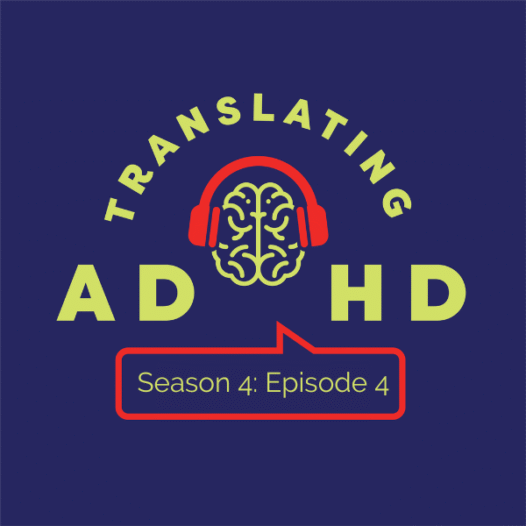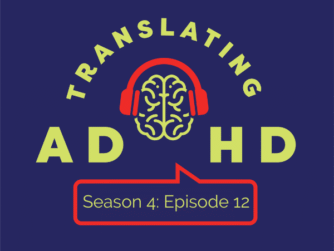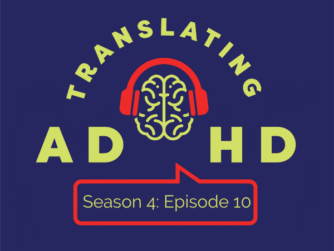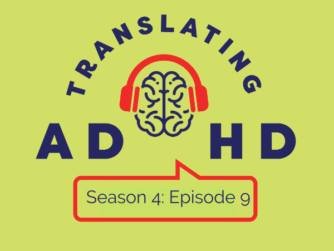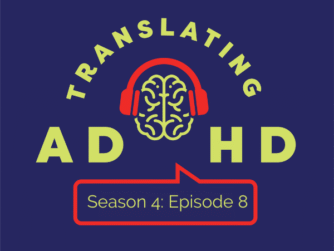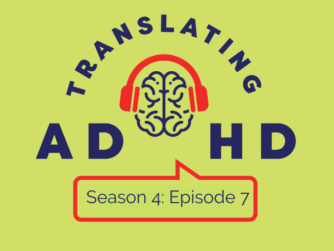This episode revisits the coaching concept of journey thinking and why it’s especially useful for people with ADHD. Rather than fixating on a distant outcome or an idealized destination, journey thinking asks you to stay on the current “stepping stone,” notice what’s actually happening, and get curious about the next possible step. Asher and Dusty explain how detaching from outcomes reduces magical and all-or-nothing thinking, makes small wins visible, and protects motivation when progress is slow or messy.
They walk through real coaching examples: reframing career identity by valuing advocacy work, making small workplace changes (notifications, meeting timing, tracking commitments) that dramatically reduce overwhelm, and using gut sense plus staged information-gathering to find a middle path in big decisions. The hosts offer two practical mantras — “I’m here now” and “What can I do?” — and emphasize starting small, measuring success beyond outcomes, and building resilience by keeping yourself in the picture.
Episode links + resources:
For more of the Translating ADHD podcast:
- Episode Transcripts: visit TranslatingADHD.com and click on the episode
- Follow us on Twitter: @TranslatingADHD
- Visit the Website: TranslatingADHD.com
Episode Transcript:
[00:00:00] Asher: Hi, I am Ash. [00:00:03] Dusty: I’m Dusty. [00:00:03] Asher: And this is Translating ADHD. Listeners, before we get started, just to let you know, I do have openings for new clients. So if you’ve been thinking about ADHD coaching or coaching with me in particular, please do reach out by filling out the form at www.coachasher.com. I do also offer a sliding scale, so if cost is a challenge for you, don’t let that stop you from reaching out.So, Dusty, you wanna tell our listeners what we’re gonna talk about today?
[00:00:35] Dusty: Today we’re gonna talk about journey thinking. [00:00:38] Asher: This is revisiting a topic that Cam and I have talked about a couple of times previously on this podcast. I recently re-listened to Season 2, Episode 2, where Cam and I really go into journey thinking and how that relates to the coaching process.I would certainly encourage listeners who want to know more about journey thinking and more about ADHD coaching to revisit that episode. It’s a great one. But today we’re gonna bring a bit of a different perspective.
So the reason I wanted to bring up this topic today is, there was a conversation that happened in our Discord server after the season opening episode where I talked about where I am on my own journey, which has not been without its difficulties. Something I said in the Discord server was journey thinking which was actually a huge aid to me during that time to sort of stay in the present to orient myself to what I’m able to do now to stay on the journey and to not lose hope or to not crumble under the immense amount of overwhelm that I was coping with at the time.
[00:01:45] Dusty: Yeah, I remember that. And listeners, just a gentle reminder that we do have a Patreon and a Discord group that you can join, and it’s very fun and great. And that’s where the discussion happened, around the episode, right? That’s what gave you the idea for this. [00:02:03] Asher: Exactly, Dusty and listeners, if you visit www.translatingadhd.com and click on the Patreon link, to find our Patreon. And for $5/month, you can be a part of the Discord server, and pretty soon we’re gonna be bringing some new monthly events to our Patreon so stay tuned for that. We will have more information for you next week on that one.So I wanna start with the same metaphor that I’ve shared every time we’ve talked about journey thinking on this podcast before, which is the idea that you are standing on a stepping stone in the middle of a foggy pond, and the fog is so dense that even though there are stepping stones all around you, you cannot see them. So you cannot see where the next stepping stone is.
Destination thinking is hopping in the water, getting all wet and kind of flailing. Flailing for that one outcome that you’re looking for. Journey thinking is about being where you are standing – on the stepping stone, getting curious and trying to lift the fog enough to see what the next stepping stone might look like.
And the real power of journey thinking is when we orient ourselves to detaching from an outcome or detaching from a particular destination. Oftentimes, we see possibilities that were not visible to us before. This happens to me a lot in my coaching relationships. I’ve coached people through job changes, career changes, significant relationship changes, significant life changes of all sorts. It all starts with the idea of let’s detach from what I think should be and start to get curious about what is in the here and now.
[00:03:56] Dusty: Yeah, very well said. I think that’s the part that our brain always wants to skip over, right? It’s so hard to bring our attention away from all the mental churning and all the should do and to-do’s and be like, okay, what are you doing though? Like, what’s happening and why? [00:04:17] Asher: Exactly Dusty, and this is particularly true. The moment that our clients are coming to ADHD coaching – because something’s not working, because there are pain points, because they are overwhelmed, because life doesn’t fit, etc. Moments like that, it can be really, really tough to access curiosity because our clients just want a solution for their pain points. They want to be out of discomfort.So journey thinking is about, let’s get present in the here and now. Let’s get out of this reactive mode and let’s start with just being where you are, even if where you are right now is not a comfortable place. Just because it’s uncomfortable doesn’t mean that there’s not an opportunity to learn, to discover something new, to lift the fog a little bit. So often with ADHD, we think let’s solve the discomfort first. There’s that magical thinking of if I can just get caught up, if I can just get somewhere different than where I am now, then I will be able to see where I’m headed.
Journey thinking is about leaning into the uncomfortable place, being exactly where you are and holding the fact that two things can be true. You can be uncomfortable in this place, but that doesn’t mean there’s not an opportunity for curiosity, new awareness and growth.
[00:05:42] Dusty: Yeah, I’m really grateful to you and Cam for having taught me this language and this perspective because even though I went through ADHD coach training, I don’t know that this is something that I learned in a really nuanced way. I think it makes me a better coach because I get that so much with clients coming to coaching and they’re trying something and then they go, it didn’t work so I’m not doing it. And they keep coming to coaching with the same story, just looking for the next thing, the next thing, the next thing. They don’t see the pattern that they’re in.It’s really not the thing but what happens when you’re trying to do the thing. Like it’s, the call coming from inside the house, right? We are not just gonna outrun this and it could be really disempowering. You can be working with an ADHD coach and still have a really disempowering experience if all you bring to coaching is “I tried that and it didn’t work. I am still not doing it.”
Usually, I’ll respond, “cool, you’re still not doing it. That’s actually what I was hoping to hear. That’s what I thought I would hear. That’s what I figured. I would hear but what does that actually entail? Tell me about still not doing it. How did you still not do it?” That’s what I want to know. And it can be really hard to slow people down and to get them to actually talk about it, but as you know, the definition of insanity is doing the same thing and expecting a different result.
So if we just keep coming back to coaching with “well that didn’t work. Let me try something else. Well, that didn’t work. Let me try something else…”. We have to get outta that.
[00:07:08] Asher: Exactly Dusty. And alongside that magical thinking that there’s some different place that we can get to that will make everything easier, that will bring all of the clarity that will show us exactly where we’re going.Another thing that journey thinking helps us get out of as folks with ADHD is all or nothing thinking because all or nothing thinking is entirely rooted in attaching to some outcome in the way things should be, the way things should look. This is something I’ve really struggled with in the last couple of years because my life right now looks very different than what I would have anticipated four years ago. Four years ago, I was thinking, “okay, I finally “arrived”. I’m here, things are gonna be more settled, life is gonna get easier from here.”
And then I had the exact opposite experience and it was really easy to get dragged down into – why am I still here? Sort of a victim mentality or imposter syndrome, just all of the things piling on. But coming back to journey thinking was a huge aid to me. There again, journey thinking helps us orient to the present to be where we are, even if that’s uncomfortable.
And listeners, you know, I love a good mantra. There are two that served me well in this time and are still serving me well, and they kind of go hand in hand. The first is, “I’m here now. I’m here now. Whether I like it or not, I’m here now.” That’s just true. That’s just real. And saying that to myself kind of helped me let go of the desire to be somewhere else.
The magical thinking, the frustration or anger that my life isn’t looking the way that I thought it should look at this stage, and then following with – what can I do? Because so often I would get stuck in all of the things I couldn’t do or all of the things that I’m not able to address at this time.
And so taking a breath and being like, well, okay, I’m here now, what can I do, kind of helped shift my perspective away from the shoulds, the grief, the frustration, and into, okay, this is where you are – what can you do to move forward in some way, even if that way is really small. And in the last few years, sometimes progress has felt very, very, very painfully slow, but it hasn’t been none.
Over time that progress has added up. And that is something we can be really bad at seeing as folks with ADHD is how small wins, small successes build over time. We can be really bad at understanding that success and struggle, I say this all the time, success and struggle can and do go hand in hand.
They are not mutually exclusive concepts and we so often tend to think that it’s one or the other. That’s that magical or all or nothing thinking that if I’m being successful there won’t be struggle. Well, that is not true. We are always going to struggle. Life is always going to throw us curve balls, and we are always going to have ADHD.
Even if we are managing it well, it is still going to impede us and get in our way in certain ways. So learning how to hold both of those things to be true and learning how to contextualize success in the moment, success in my last couple of years did not look like success in the years proceeding because my life was different. It was harder, it was more overwhelming. I was struggling in ways that I wasn’t struggling before. And so I had to give myself some grace and learn how to measure success differently.
[00:11:10] Dusty: I’m right there with you and I think what you said there was really profound, that success and struggle can go hand in hand because I do think, going along with that magical thinking, of your princess is in another castle, like, oh, it’s just gonna be the next planner I buy.Or like you said, once I get somewhere else, then I can. I can’t count the number of times that I’ve said that to myself and to others around me. And then I’ve heard clients say once I “x” then I’ll “y”. And you really do have to just shift into okay, “x” is never coming. There’s no end to the to-do list.
There’s no magical future where you nail all your routines and you get it going and then…you know what I mean? And I mean, with nuance, I think it also doesn’t behoove one to be like, okay, well nothing’s ever gonna change so someone might as well do everything.
Now there’s a nuanced space in between later and now. I like to tell clients to think about now and then next, you know, that kind of helps me give myself a bit of space. I’m going on a bit of a tangent, but anyway I think what you said there about, you know, success and struggle going together is really important because we have to be able to recognize that in a lot of ways we are already succeeding, right?
We can and should give ourselves credit for the effort that we’re doing now. I often say to clients, when I’m doing consultations, I often say, ADHD splits apart effort and outcome. It splits apart like intention and effort. So you can intend to do something and then not do it, but you can also do a thing and it doesn’t go the way that you thought it would go, or you don’t get the outcome you wanted, right?
So for example, I could go to the gym every day for a month. I could go to the gym for 30 days with the goal to lose 10 pounds. If I am having a hard time going to the gym and I’m not working out enough, or I’m maybe not sleeping or eating right, I could go to the gym 30 days in a row and not lose 10 pounds.
I could work on my taxes every day for a month and not get my taxes done. I could clean my house every day and still not feel like I got it to the level of cleanliness that I anticipated. And if I’m putting in all that effort over and over and over and over and not seeing the outcome, I’m liable to not count it at all.
And that’s really demoralizing, right?That doesn’t do a lot for our motivational wiring in our brain. So one of the things I think is really helpful about journey thinking is bringing clients’ awareness to how successful they already are based on what they’re already doing and how much they’re already trying.
If you are not getting the outcome you’re looking for, it’s not always because you’re not trying hard enough. That’s not always the reason. Sometimes you’re trying hard enough but you’re trying in the wrong way or you’re using the wrong tool or whatever. But if we always just go, well, I’m not getting where I’m trying to go so I must not be trying hard enough, let me try harder – it’s just an exercise in futility.
I find it’s really helpful for people to actually acknowledge how much effort they’re putting in and to be able to give themselves credit for how hard they’re working. And that’s like a huge shift that is really, really healing for a lot of clients.
[00:14:08] Asher: Absolutely Dusty. Nothing, nothing halts effort for me faster than getting stuck in that mentality that I should be doing more, that I should be efforting harder, or that I should be working harder. And nothing helps more than orienting myself to where I am being successful.Another way that I see what you just talked about showing up with clients, is thinking about their journey to this point. So many clients will come to me with this story that their life has happened to them more than I’ve happened to it. I have been a failure up until this point in my life. So learning how to measure against something other than outcome is helpful here too.
I am working with a new client who has a lot down when it comes to her career. She’s highly educated, she’s done some interesting work in a number of different fields, but she absolutely dreads the question, what do you do for a living because she feels like she doesn’t have the “right answer”. She feels she should have a better answer and have more to show for the effort that she’s put into this point in her life. And the last time we met, it was really interesting because she was talking, this is kind of a sidebar, but she was talking about all of this incredible volunteer and advocacy work that she was doing and had done in the past for underserved populations and how fulfilling that is for her.
And I called out, “is that not being successful? Does success have to look like a certain career path or a certain career title? Is there not success in what you’ve done here? Because this all sounds incredible to me”, and that led to a really interesting conversation where even in those roles, she tended to diminish herself.
She talked about a local paper wanting to take a photograph with her and some other people involved in a particular event, and she told the newspaper, oh, you don’t want me. I’m nobody. So you see how she’s completely discounting where she’s being successful, where others are trying to recognize her because it’s not fitting the destination she has in mind of being able to answer the career question with confidence.
So listeners learn how to measure against something other than outcome. I tend to not attach outcomes to certain goals. As you all know, I kickbox. It has been a rocky journey. I have never been as consistent as I would like, but I don’t attach hard goals to it. My goal is to just be more functionally fit to keep my body in good enough shape, and if I go often enough, I am achieving that goal. And someday, maybe I will attach another goal to that. Maybe I will be in a place where I can attach some positive motivation.
But there’s an important distinction. Are you attaching from a place of desire and want? Is there a positive outcome that you’re working towards or are you attaching from a place of “should”? Detaching from outcome doesn’t necessarily mean never ever having any goals. What it does mean is orienting those goals to who you are and what matters in your life, not what you think you should be doing, not where you think you should be at this moment in time.
Something else that I think journey thinking really does for my clients is it does this twofold thing of helping us put ourselves in the picture and build some resilience. I have a client who is currently working in a corporate environment, so she is a former expat that moved back to her country of origin and she wasn’t sure if she was going to like that lifestyle or not because she really enjoyed the expat lifestyle, but she had some career goals that made taking this particular job something of interest to her. She wanted to see how well she would do in a corporate environment and she wanted to capitalize on some learning opportunities that would come from this change of pace for her as somebody who had typically worked only in startups.
When the move first happened, it was really tough for her. There was a lot of one down. Corporate environments are really tough for people with ADHD in general, so there was a lot of struggle there.
For a time she really lost sight of her why. But we had this powerful shift in our coaching where she reconnected to what she loves about what she does. She started attending events outside of work and reminding herself why she was doing this particular job and how it was going to serve her and getting where she wanted to go.
Even though the job itself hasn’t changed, the struggles of corporate life haven’t changed, the ADHD of it all is still in the mix but there is now this positive motivation that she is attached to because she’s remembering to put herself in the picture. Her goal is not to climb the corporate ladder. Her goal is to get a specific set of learning from this job that will enable her to seek the kinds of opportunities that she wants to seek in the future and to do well enough to be able to stay in this position and do that.
So just that shift in perspective has been really, really helpful because now she’s seeing herself in the picture and so now she has some resilience. When the one down comes in, when the corporate bureaucratic mess of it all, that’s so hard for those of us with ADHD, becomes overwhelming and frustrating, she’s able to reconnect to that bigger why, why am I here, why am I doing this. And that’s the positive motivation, not necessarily being successful in the corporate job, but being successful because I have my own motivations and my own ends that I’m working towards in part by spending a couple of years in this role.
[00:20:49] Dusty: Yeah, I love that. And it’s so funny how that happens, right? Your dream sort of becomes your nightmare. And sometimes it’s not about making some big sweeping structural change but it’s just about getting back to basics, right?I think that’s what coaching is so powerful for. I had a client who was also really struggling with feeling competent at work and she had all these stories. True stories about health issues that she was going through and life issues that were making it hard for her to focus and limitations. Her story had a lot of “I’m limited because of X, Y, Z”.
And I was like, well, let’s just get a little bit curious about what’s going on with your work processes. And what we actually discovered was that Slack was a huge source of distraction. And the way that her day was set up with meetings and her work was not serving her at all but instead just making her feel super overwhelmed. All it took was like just a couple really simple switches that honestly, she came up with. All I did was go “hey, what’s going on over here? Let’s just look at it. Let’s see what’s happening. Why isn’t this working? What happens when you start your day? What happens by 10:00 AM? What happens by 2:00 PM? Where are you at? What’s going on and how did you get here?” And she was like, you know what, I’m gonna add a little bit more structure to when and how I check emails. I’m gonna add a little bit more structure to when and how I check my Slack notifications. I’m gonna leave some Slack channels that I don’t need to be in. I’m gonna change my meetings around.
And just with these simple few changes, honestly, she felt so much more efficient and effective. All of a sudden she had clarity and she knew what she was working on. She knew what was going on at her job. She knew what she was supposed to do. She knew what the deadlines were. And from there it became really easy to start spotting all the little “potholes” that got her stuck. Within a few weeks of making these changes she said, “you know what? I’m totally overpromising things to people and I don’t have those promises written down anywhere. Like, I don’t actually even know. I don’t have a list of all the things that I’ve promised to people and when they’re due. So how do I know if I can say yes to something?” And I’m like, yeah, I don’t know. And so all it took was her making a little database or spreadsheet of all the things that she had committed to that she could reference before committing to something else.
And lo and behold, she had the answers all along and all it took was a few small shifts, and the way that she felt about herself at work was totally different. She still had those physical and health limitations, but it wasn’t the health limitations and it wasn’t incompetence. It wasn’t, you know, I’m not good at my job and I need more training. It wasn’t, I’m in the wrong role and I need to get a new job. It was just the way she set up her day didn’t work, but we had to slow it down and like really slow it down. And sometimes I feel like what we’re doing when we’re doing journey thinking is like taking a slice or a section of your life and putting it in a microscope, between two slides.
It can be really hard to convince clients to do that sometimes especially when it feels like everything’s on fire. It’s like, well, what good is it to just talk about why my laundry’s not getting done on Mondays and where I’m putting my laundry and why I’m not following through with my intention to do laundry on Mondays.
I think sometimes that can feel so minute to a client and so they wonder how is this gonna help everything? But, it’s like science, right? When we get under the microscope and we look right at something, you know, many years ago we didn’t know why we had illness and we attributed it to mystical factors. And it wasn’t until we put something under a microscope and we’re like, oh, there’s this invisible bacteria here that we can’t see. That’s actually what’s causing this. Now we can have a proper intervention. But it’s the ADHD bacteria of our lives we have to put under the microscope. I wasn’t 100% sure that metaphor was gonna swing all the way back around. I’m very pleased with myself that it did, but yeah, it’s so funny how that works.
[00:24:43] Asher: I love that you stuck with the metaphor all the way through, because I had no idea that you were unsure until you said it at the end. I was just sitting here going, “ooh. This is good. This is really good”.So the last thing I want to say, Dusty, about journey thinking is something really powerful I’ve noticed with my clients who are really embodying journey thinking, and this is true for me as well. Like anything else, this takes practice, right? So if you’re not here, that’s okay. Learning how to embody journey thinking has been a practice for me since the idea was first introduced to me and became a part of my coaching almost a decade ago.
And so give yourself some grace here. If it’s a new concept for you, start small. Start with my dual mantras of “I’m here now, what can I do?” But, for my clients who are a little farther along, I think something really powerful in particular for people with ADHD, I’ve come to think of ADHD folks as being emotion led. You know, we often think of our emotions only in terms of dysregulation, right? Then something happens, we have our negative feelings about it, we tell ourselves all these stories about ourselves, right? We catastrophize, we can go from, I’ve missed a deadline to I’m the worst person in the world.
So that is certainly the downside of being an emotional being with ADHD. But, I think the upside is learning to listen to our gut. I had a session with a client the other day where she was deciding between staying in this startup that she’s a part of where things are uncertain, but some new, exciting work is happening or taking a new job, which she needed to have an answer for the week after our session. So we’re trying to get some clarity in this session about whether or not she’s going to take this job that would lead to a potential PhD program. And for three quarters of our session, we’re kind of weighing pros and cons and we’re not really getting anywhere.
And so I paused at one point and just asked her, “if you had to decide right now, what would you do? What does your gut say?” And interestingly enough, and this is right back to sometimes the solution is something we can’t see until we can, she found this middle ground solution. I’m gonna say no to the job, but I’m not gonna say no to the PhD program yet.
I’m going to go ahead and apply. But I’m also going to give myself until January in this startup to see where things are. And in the meantime, because one of her concerns was moving from a large metropolitan area to a small college town and whether or not she would like that lifestyle shift, so in the meantime, there is an opportunity to go work with these people, to go work with this lab, to get a feel for what the work looks like, and also get a feel for what it’s like to be in this program by talking to other grad students, by spending a couple of weeks in this location to start to get a feel for what it might actually look like to live here.
And so ultimately what she needed was more information and information that she doesn’t have yet at this moment, in her journey. But when she tuned into her gut, when we just asked, what does your gut say, all of a sudden, here’s this creative solution that allows a little time for more information.
It doesn’t have to be a decision right now, this second, I can wait. And I can gather information in the meantime that will better inform and give me a better sense of what is right for me.
[00:28:39] Dusty: I like the client stories that you’re telling me ’cause I think that you’re a really strong coach when it comes to journey thinking. I know that’s sort of your whole jam.I hope that this is something that most, or all coaches are doing with their clients because I do think that, especially with ADHD, maybe more than with other neuro types, this is so necessary and so helpful. It tends to be the thing that makes the biggest difference and it’s made the biggest difference for me for sure.
[00:29:05] Asher: Dusty, I couldn’t agree more. My coaching practice took a powerful shift when I started doing journey thinking as a core practice in every coaching relationship. Even for those clients who come in a place where they’re right where they want to be, and they really just need help with the ADHD of it all, journey thinking is a helpful concept because with ADHD, the stuff behind the stuff is not always obvious. So even in a case where we’re not making big, sweeping changes to a client’s life, we’re just trying to make small tweaks so that they aren’t drowning and becoming victims of their own success, being able to approach it with curiosity, letting go of the shoulds, letting go of what I ought to be doing or comparing to other people can be so powerful in finding creative solutions.And for most of my clients I often say that with ADHD, simple and easy are not the same thing. So often when we do get to a solution for something like laundry or answering emails, the solution is pretty “simple”. It’s not anything complicated. It’s not anything too onerous. But finding what we needed to find to get that simple solution wasn’t easy because ADHD can make it really challenging to see what we need, what support looks like for us. And because we have this learned behavior of looking to others to see what we’re “supposed to do”.
We tend to just throw stuff at the wall to see what sticks and get frustrated rather than getting curious about what it is we need. So even for those of you whose journeys may not involve sweeping change as mine has and some of my clients – having journey thinking is just such a powerful concept for ADHD in general.
I think it really aligns with how our brains work. It allows us to tap into creativity and novelty and to let go of shoulds and one down.
Dusty, I think that’s a good place for us to wrap for today.
[00:31:20] Dusty: I agree. [00:31:21] Asher: So listeners, until next week, I’m Ash. [00:31:23] Dusty: And I’m Dusty. [00:31:24] Asher: And this was the Translating ADHD podcast. Thanks for listening.
